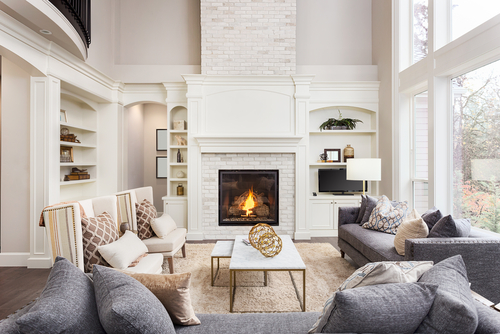 How many times have you wished to have the warmth and charm of a fireplace, until you thought about all the mess and hassle of logs and embers, not to mention the kindling and constant work to keep the fire going. That’s why many people are discovering the ease and style of a gas fireplace. The thing that always surprises people most is the realistic look and actual warmth of a gas fireplace. This is no plastic log over a lightbulb. They always ask, What kind of logs do you use in a gas fireplace? The gas logs in a gas fireplace are made from cement, ceramic or ceramic fiber blends that are carefully crafted and painted to look just like real wood logs. You can even specify a species of wood!
How many times have you wished to have the warmth and charm of a fireplace, until you thought about all the mess and hassle of logs and embers, not to mention the kindling and constant work to keep the fire going. That’s why many people are discovering the ease and style of a gas fireplace. The thing that always surprises people most is the realistic look and actual warmth of a gas fireplace. This is no plastic log over a lightbulb. They always ask, What kind of logs do you use in a gas fireplace? The gas logs in a gas fireplace are made from cement, ceramic or ceramic fiber blends that are carefully crafted and painted to look just like real wood logs. You can even specify a species of wood!
Log sets for gas fireplaces are available in a wide variety of styles, to suit your décor and the style of your hearth. Stop by our Snow Hill, North Carolina, showroom and you might be amazed by the variety of options of gas log sets we offer. You can choose wood species—oak, birch, pine, and more, even driftwood, with charred effects or split-log looks. You can also select log layouts—more logs or fewer, a neat stack or a more rustic, asymmetrical pile.
Whatever style you choose, gas logs are made to withstand high heat, and should last two to five years, depending on how much you use your gas fireplace.
The best part about a gas fireplace is that you don’t need a chimney. Of course, it’s easy to convert a wood-burning hearth to a gas fireplace. But if you don’t have a chimney, you can also choose the look of your mantel and surrounding hearth, to create exactly the look you want, all thanks to ventless and direct vent designs.
Direct vent and vent-free technology are two great ways to add a gas fireplace even if you don’t have a chimney or flue. All that’s needed is access to propane gas.
Ventless models have a regulator that produces a fine gas-air mix that allows the gas to burn cleanly, and reduces the fumes associated with traditional gas fireplaces.
With direct venting, a single dual-chambered pipe is installed directly through a wall to the outdoors. The pipe simultaneously draws air for the fire from the outdoors, while it expels the fire’s combustion byproducts to the outside.
Because the space requirements between the fireplace and wallboard or wood are minimal, a gas hearth can be installed almost anywhere. That means you can incorporate cozy charm into just about any room, including living rooms and family rooms, but also kitchens and dining rooms. You can also convert traditional fireplaces to a maintenance-free propane hearth with a gas log insert with minimal work.
Propane-fueled fireplaces add ambiance—but they also provide efficient supplemental heat without the mess, smoke and ash of a wood-burning fireplace. And a gas hearth is much safer. No more playing with matches and waiting for tricky kindling to catch—you can turn on and adjust the flame with a wall switch or even a remote control, and turn it off when you are done. No waiting for embers to burn out or worrying that they will flare up again.
Nothing beats the cozy charm and ambiance of a fireplace. Let the team at Rand Wade show you how easy and affordable it can be to install a gas fireplace. We service and install everything we sell, and we stand by our work.
Contact us or stop by the showroom today!